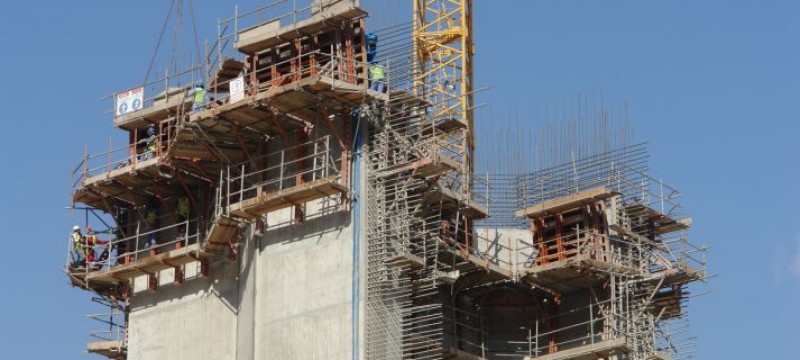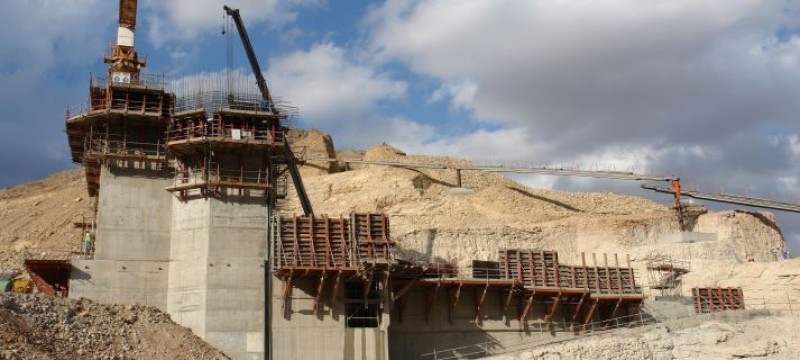-
Philippines
Copyright © 2025 Powered by BCI Media Group Pty Ltd
Confirm Submission
Are you sure want to adding all Products to your Library?
Contact Detail

 The Wadi Dayqah Dam is set to capture an estimated 60 million cubic metres of potable water that previously flowed down the deep desert canyons out to sea each year. RMD Kwikform supported the dam construction using its Rapidclimb climbing formwork system.
The Wadi Dayqah Dam is set to capture an estimated 60 million cubic metres of potable water that previously flowed down the deep desert canyons out to sea each year. RMD Kwikform supported the dam construction using its Rapidclimb climbing formwork system.

Watching the periodic floods surge down the Wadi Dayqah in Muscat is not only an awesome sight, but one to fill farmers and other inhabitants of the region with frustration, witnessing the precious resource racing out to be lost in the sea. No more, however, as the Gulf’s largest irrigation dam project to date nears completion. The Wadi Dayqah Dam is set to capture an estimated 60 million cubic metres of potable water that previously flowed down the deep desert canyons out to sea each year.
RMD Kwikform played a pivotal role in assisting the joint venture company with the construction of a 390 metre long, roller compacted concrete dam. While the client – the Sultanate of Oman Ministry of Regional Municipalities, Environment and Water Resources – estimated that prior to the construction of the new dam, only 15 percent of the perennial flow was utilised through existing irrigation channels.
The new dam will be able to store up 100 million cubic metres of water. Thanks to the work of Vinci Construction and Consolidated Contractors Company Oman LLC the JV contractors who constructed the dam, a series of pipelines will in future carry treated water to the villages of Hayl al Ghaf, Daghmar and Quriyat. While these downstream settlements will gain some 10 million cubic metres of water annually for mainly agricultural use, another 5.7m and 19.3m cubic metres will be consumed as drinking water by the Quriyat and Muscat Governorates respectively. The development of the Wadi Dayqah Dam provided RMD Kwikform the opportunity to demonstrate its ability to supply the very largest civil engineering projects with specialist formwork systems and professional service.
While in many instances, contractors find hiring formwork more economic, the scale and duration of the dam project led the JV contractors to choose to purchase all of the equipment; the equipment being supplied through RMD Kwikform’s huge depot in Dubai.
At its highest point the dam stands 73.6 metre high, spanning between its bedrock abutments in the wadi walls. Construction began in 2007 with RMD Kwikform supplying the first of the formwork requirements in the April, for the casting of a diversion channel which runs centrally beneath the dam wall. RMD Kwikform delivered sufficient quantities of its well proven and widely used GTX Beams and Superslim Soldiers to facilitate the casting of the 55.4 by 15.53 metre wide diversion channel. The products were employed as single sided formwork shutters for the massive, 4.0 metre thick base section of the channel. The forms were restrained through the use of adjustable props. The walls of the diversion channel, at 2.5 metres thick were formed in two lifts using GTX Beams and Superslim Soldiers again, but this time as a double sided formwork application using RMD Kwikform Rapid Ties to restrain the formwork and construction loads. Finally single sided forms were employed again to cast the 2.5 metre thick roof slab to the diversion channel. Possibly the most complex aspect to the construction of the Wadi Dayqah Dam concerned the Intake Tower which was constructed in advance of the dam wall.
Standing off-centre to the dam itself, it rises 56 metres above the canyon floor and has a base 8.0 metres thick. Complicating the construction sequence, and preventing the RMD Kwikform shutters from being tied through from face to face in many instances, were the proliferation of intake pipes and sluice gate assemblies that the tower accommodates. The solution devised by RMD Kwikform’s technical design department involved adopting a 2.25 metre high, single sided form arrangement, so as to reduce concrete pressures and avoid the need for through ties. Once the concrete has gained sufficient strength, the shutters are stripped and raised to the subsequent pour position using RMD Kwikform Jump Form brackets secured to the previous pour using RMD Kwikform Anchor Screws that were cast into the top quartile of the previous section. Working platforms with handrails are an essential component of the system.
Despite the imposing size of the Wadi Dayqah Dam wall, the design of the formwork and method of construction actually mean the concrete pressures are far lower during placement than is normally experienced when concrete is poured or pumped into forms. As the core of the dam is compacted using 30 tonne vibrating road rollers to compact concrete with a slump of just 20mm, the operatives distribute a more fluid concrete mix along the edge zone, to a width of approx 400mm from the formwork faces. This area of concrete is compacted conventionally with vibrating pokers.
RMD Kwikform’s design office carried out full calculations for all of the loading conditions relating to the various formwork elements on the project and supplied its clients with comprehensive detailed drawings, and method statements where required. To ensure that there were no problems with the interpretation of the drawings, RMD Kwikform’s deployed an experienced engineer to the site at the beginning of the project for a period of 2 weeks, to train the labour force in the use of the systems supplied and give guidance on health and safety issues.
For the upstream wall of the dam (which will mainly be hidden beneath the waters of the new reservoir) a similar construction method was adopted to that for the Intake Tower. The downstream face, however, steps back like the sides of an ancient pyramid, and featured the use of 1.2 metre forms assembled using GTX walers supported using more of the Anchor Screws with brackets and telescopic props.
At the top of the downstream face, an overhang was constructed by casting a Rapid Tie nut and plate into the last pour, and cantilevering out at an angle fixed to these Anchors to support the vertical forms to construct the overhang. Telescopic props and access platforms were again provided by RMD Kwikform. An important aspect to the level of service and functionality which RMD Kwikform is able to offer compared to its competitors is the company’s capability to respond to customer’s project specific requirements including the design and fabrication of special components. In the case of the Wadi Dayqah Dam the need for bespoke formwork elements were required to form the curves to the spillways, and the ‘splitter teeth’ which encourage the flow across the top to do so smoothly. The second stage of the impressive infrastructure project got under way also in 2007 with the construction of a huge treatment works some seven and a half kilometres downstream of the dam site. This plant will be able to process 125,000 cubic metres of water per day.



